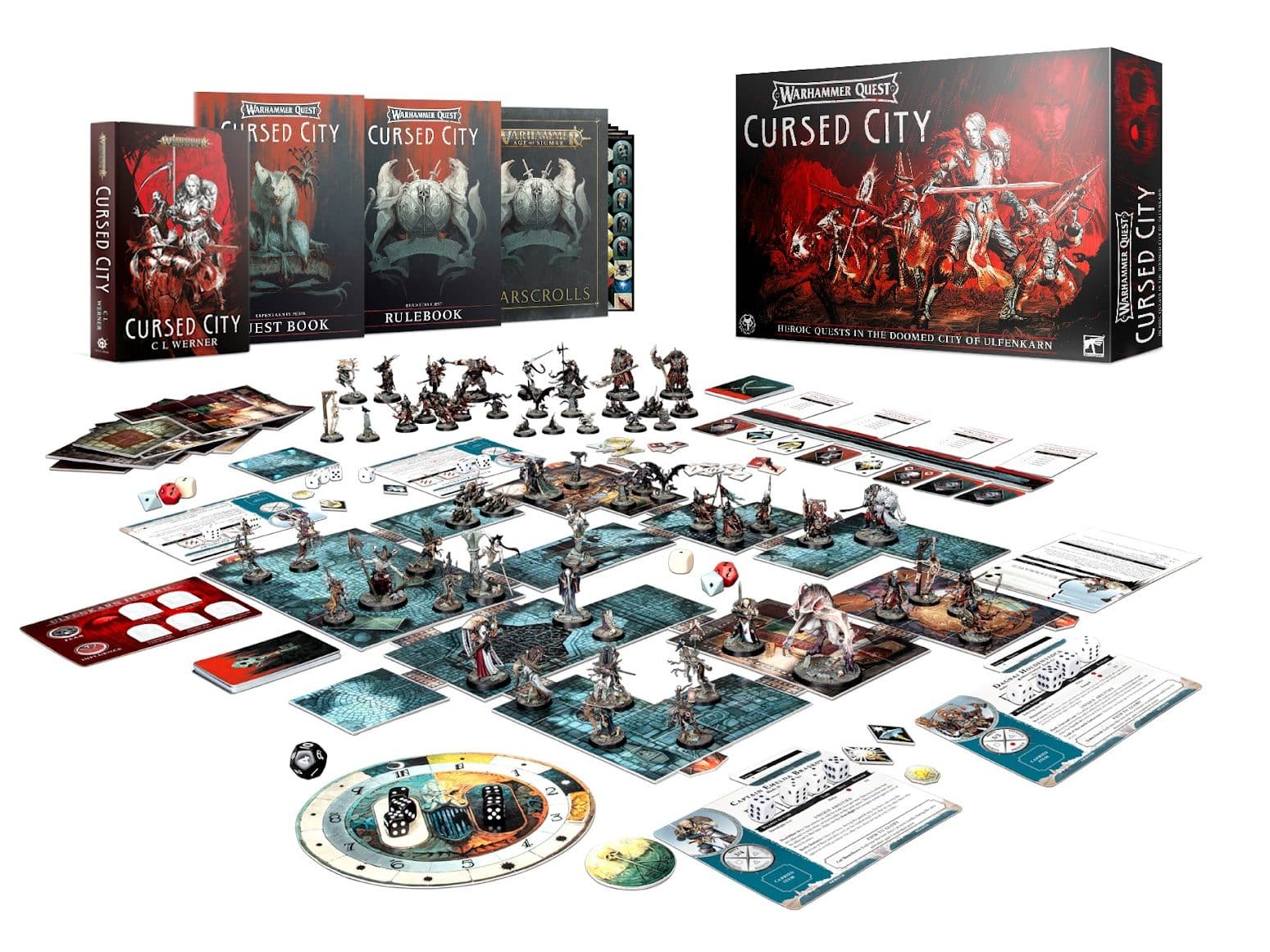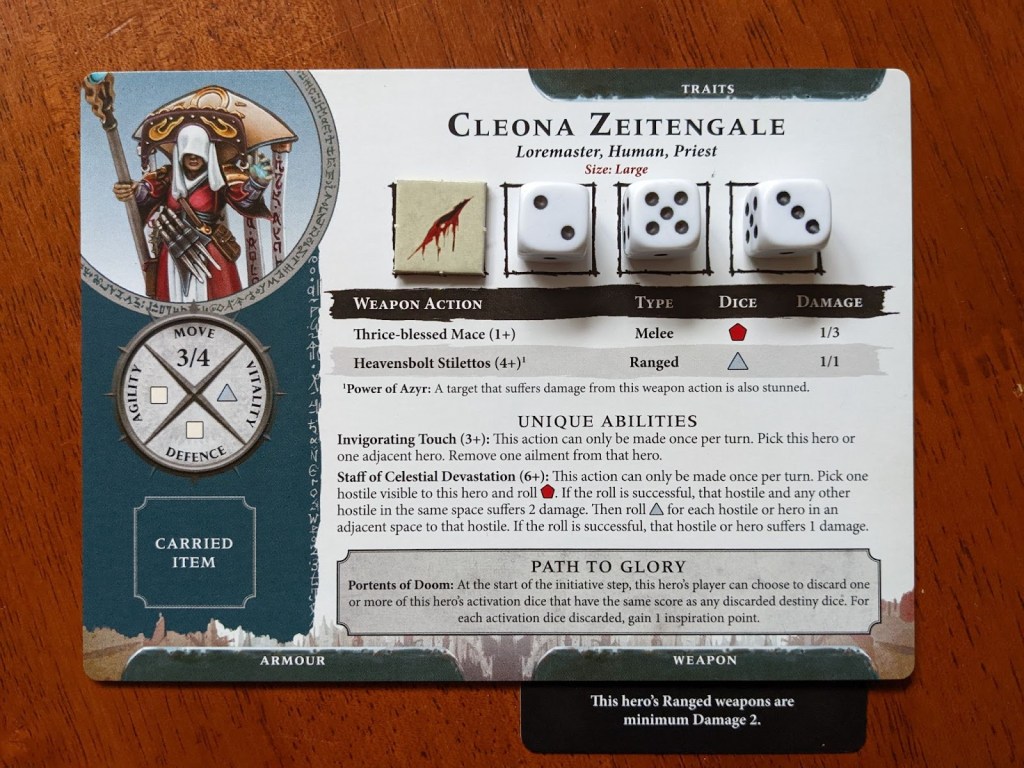Warhammer Quest: Cursed City is a 1-4 player cooperative dungeon-crawl campaign game originally released back in April of 2021. It sold out globally within hours, and then it was bizarrely announced via Twitter that same month that it would not be seeing a reprint.
Warhammer fans clamoured for any inflated-price copies they could find on the resale market, both for the positive buzz about the game itself, and also for the 60 beautiful new Warhammer miniatures featured in it.
Read: The 8 best dungeon crawler board games for adventurers
Eight months passed until completely out of the blue, Games Workshop announced that Cursed City would be returning in 2022. Advance copies shipping mid-year would be available to preorder during a strict two-week window in March, followed by a full-scale retail relaunch hitting before Christmas.
I couldn’t throw down my preorder fast enough. But having now played many games of Cursed City, I find myself surprised by how shallow it is.

Deceptive Simplicity
It’s a real bummer that Warhammer Quest: Cursed City looks so intimidating at first glance, as Games Workshop have put a good degree of effort into making Cursed City enormously easy to get on the table – particularly compared to most of their other products. The game’s core rules are quite cleanly written and laid out, and only take up about 20 pages, including diagrams and art.
They’re preceded by a nifty step-by-step tutorial for the fundamentals of movement and combat, too. What depth there is to the gameplay comes from the interplay of unique hero, monster, and mission rules, as well as how those are all augmented by acquired treasure and upgrades, random crisis events, the race against the in-game clock, and so forth.
However, after the first couple of hours with Cursed City, it becomes clear how deceptively simple this game really is.
Four heroes from the pool of eight are used in each game, with each game representing a daylight raid into a different neighbourhood of a deadite-infested city. ‘Fear’ and ‘Influence’ are the two key metrics kept track of throughout the campaign. Letting either grow too high, or letting more than half of your heroes die in the field, spells a full square-one restart for your whole campaign.

Each hero has a base total of four actions they can make in a turn, represented by slots filled with six-sided dice, which are rolled and slotted at the beginning of each turn. Actions such as walking and basic attacks have a skill rating of 1+, and can therefore be performed in any combination, up to four times a turn by each hero. Each hero also has secondary weapons, skills, spells, and situationally specific actions they might wish to use, and these all have varying skill ratings attached.
Each injury that heroes take during a game removes one of these slots from use, until successful recovery rolls can be made. This means that one bad round of combat can send things south for your party very quickly, and elite enemies are brutally dangerous if tackled recklessly.
Specific goals of each game differ according to the chosen journey type. Feeling a bit underpowered? Dive into a Scavenge journey and dig up all the treasure you can. Is Radukar’s influence growing too strong? Launch a Hunt journey and thin the numbers of his undead legion, and so on. Whatever your objective, you’d best move swiftly through the streets as each turn brings nightfall closer, and buffs your enemies.
Warhammer Quest: Cursed City balances freedom for players to tackle the kind of game session they want against the pressures of its fail metrics quite well, and every choice made during a play session feels risky to some degree, which is thematically appropriate. Each of the eight heroes also feels well defined in character and mechanical difference from one another, and I quickly grew attached to each of them – enough that the threat of them being killed and removed permanently from my campaign felt impactful.
Each hero’s experience and acquired loot are kept track of using handily included ziplock bags which act as a ‘save file’ for each character. Each time your heroes level up you’ll gain the ability to go on a specific mission to take out one of Radukar’s five lieutenants in a mostly linear order, before finally unlocking the ability to take on the Wolf himself. Each increase of level will also make tougher enemy mobs spawn in each subsequent game too, ensuring that players can never gain too much of an edge over the armies of darkness.
Warhammer Quest: Cursed City has fantastic plastic
The included miniatures are all absolutely spectacular, as one would expect from Games Workshop. All of them come unpainted and must be clipped from sprues like any Warhammer kit, but Games Workshop wisely designed them as fully push-fit, with no glue required. Cleverly, they made the heroes out of a different colour of plastic from the baddies, so that anyone who may not feel up to painting sixty highly-detailed figures can still have each side be visually distinct during play.
All of the miniatures come with rules to field them as part of Warhammer: Age of Sigmar armies, as an added bonus – though disappointingly, none of them are particularly strong or competitively worthwhile additions to your forces.
Slowly Shambling
I’m impressed by so much of what Cursed City has to offer, and yet I truly don’t think I’d feel comfortable recommending it to anybody.
Despite the differing mission types and action-role-playing game elements core to its design, exploring and fighting feels functionally identical during your first game, as it does in your sixth game. Considering that exploring and fighting is about 90% of the Cursed City experience, that’s a major problem.
Considering too that a single game will take at least 90 minutes to complete, and that a campaign will take at least a dozen games before players claw their way to Radukar, it’s difficult to say whether the game will remain mechanically engaging for most players throughout that very long haul.
The dozen or so pages of lore and story setup included are excellently written, but the narrative of the campaign itself is entirely defined by the player’s actions, with no pre-designated ‘once you get here, read this’ beats or reveals along the way.
There is an envelope included that players aren’t meant to open and read until the very end, and there’s a tie-in novel that’s currently out of print too, but I can’t help but feel like it’d be a lot more motivating to keep playing if there were some properly crafted narrative beats along the path.
Warhammer Quest: Cursed City just feels frustratingly like a product too scared to commit to anything.
At AUD $290 it’s too damn expensive to be a lure into the broader Age of Sigmar universe of games. The sheer time commitment for the full campaign vs. how shallow its action-RPG elements are will also likely turn off most Warhammer fans who are used to playing games with much more density and customisation at their core.
It doesn’t have the storytelling depth of Gloomhaven, but it doesn’t have the mechanical depth of equipment loadout and combat like the Bloodborne miniatures game, either.
Games Workshop has promised that expansions are coming, but as of yet, there’s zero word as to what they will entail. I truly hope these can grow the game in meaningful ways because as it stands right now, Warhammer Quest: Cursed City is an entertaining game, but one that I can’t envision anybody will keep coming back to over and over again.
3 Stars: ★★★
Warhammer Quest: Cursed City
Publisher: Games Workshop
Release Date: Available Now
A copy of Warhammer Quest: Cursed City was purchased for the purposes of this review.
For more board game coverage and recommendations, you might enjoy reading the following articles:
- Stardew Valley: The Board Game review – perfect translation
- The 10 best board games for beginners
- The best puzzle board games to play in 2022
- The best solo board games for single players
- The 8 best dungeon crawler board games for adventurers
- The best story-based adventure board games
- The best board games of 2021 have been chosen
- The best co-op board games for two players
- The best tabletop games to bring out at a party
- Tabletop gaming is adopting digital tools for a brighter future





